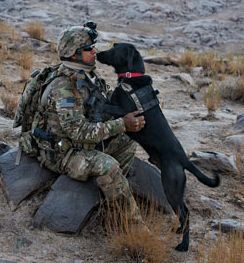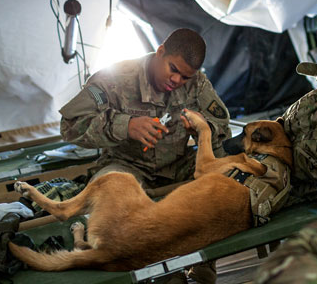You gotta love these dogs!

Yes, you guessed it: I’m at it again. The feature article in this month’s National Geographic (June 2014) is about the service dogs who work along side military staff in Afghanstan.
Adam Ferguson, an Australian photographer, showcases the determination and passion of these service dogs, in this feature entitled: Hero Dogs: The Dogs of War. The article left me feeling extremely sad and frustrated with the lack of recognition these dogs typically get, but grateful for this celebration of their “HERO” status. The historical context and descriptions of soldier-dog partnership is, however, very intriguing. Most sad was the mention that 5% of these dogs end up with symptoms of PTSD! The terrifying experience of suffering from trauma must be horrifying for a dog. Good thing the soldiers also take special care of their partner dogs.

While these “Dogs of War” are not the service dogs trained for PTSD, they remind me of the psychiatric service dogs I admire so much. In particular, I keep wanting to know: what is it that makes PTSD service dogs so effective? Its easy to imagine how a dog can be trained to sniff out bombs or drugs and perform asks such as search and rescue, but how are they trained to assist with symptoms of PTSD? Anxiety, panic, depression, flashbacks; that’s enough to exhaust anyone, never mind a dog. Clearly there is no limit to what a dog can be trained to support. No job to big for these amazing dogs!
To best support a person suffering from PTSD, a dog needs to know when, and how to provide a huge variety of skills aimed at reducing the anxiety, among many other symptoms. I’d say the most important ways a dog reduce symptoms is as follows:
- Reduce, eliminate stimulation overload
- Help person get out of bed; fight lethargy
- Provide deep pressure to calm person
- Work to prevent panic by guiding/directing the person in a crowd or other threatening situation
- Arouse person from dissociation
- Prevent emotional overload
- Take control of a situation by leading the person away from a situation to an isolated area.
Quite challenging, but impressive, isn’t it?
There is even more: these dogs need to provide help during a crisis (i.e. Call 911, bring medication/drink, help with balance, assist person to steady themselves), while also helping to manage fear (i.e. keeping strangers away, increasing safety in his surroundings, getting help, providing reality checks, assisting with escape strategies).
These PTSD dogs are available across the country and while their training is expensive, there are also a variety of special funding arrangements, grants and opportunities available. They are know to make a dramatic positive impact on both the person they serve and the symptoms suffered.
The following organizations may be of some help: Freedom Service Dogs, Assisance Dogs International, and Canines For Hope. Pet therapy associations, local farms and the SPCA are also a good bet for where you can get a good dose of ‘loving’ and support.
